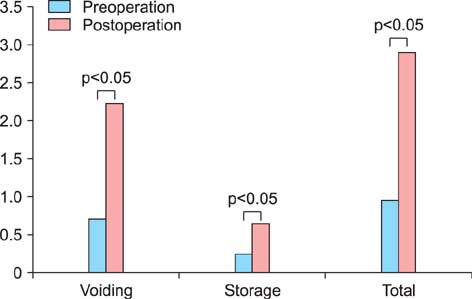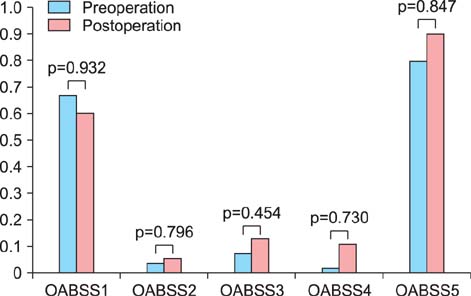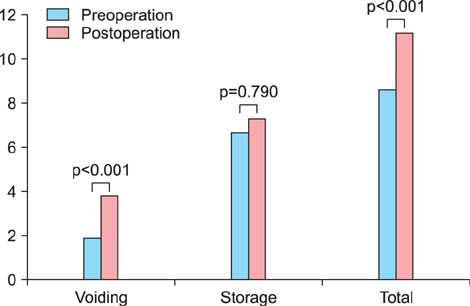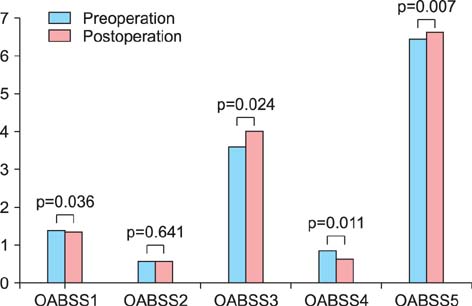Korean J Urol.
2014 Jun;55(6):400-404. 10.4111/kju.2014.55.6.400.
The Changes of Voiding Pattern After Midurethral Sling Between Pure Stress Urinary Incontinence and Stress Urinary Incontinence With Overactive Bladder Group
- Affiliations
-
- 1Department of Urology, Yeouido St. Mary's Hospital, The Catholic University of Korea College of Medicine, Seoul, Korea. uroking@naver.com
- KMID: 1885619
- DOI: http://doi.org/10.4111/kju.2014.55.6.400
Abstract
- PURPOSE
The purpose of this study is to compare changes in voiding pattern after midurethral sling surgery (MUS) between the stress urinary incontinence (SUI) group and the overactive bladder (OAB)+SUI group.
MATERIALS AND METHODS
From January 2008 to February 2011, a retrospective survey was conducted of 225 female patients who had been diagnosed with SUI and undergone MUS. The subjects were divided into the SUI group and the OAB+SUI group. Changes in the overactive bladder symptom score (OABSS) and American Urological Association-Symptom Index (AUA-SI) before and three months after the MUS were compared.
RESULTS
Of the 225 patients, 165 patients (73.3%) were classified as SUI group, and 60 patients (26.7%) were classified as OAB+SUI group. The mean age of the subjects was 54.7 years (range, 31-80 years), and the mean age of patients was 53.9 years (range, 34-80 years), and 56.8 years (range, 31-78 years) in the SUI group and OAB+SUI group. In SUI group, voiding symptom and storage symptom among the AUA-SI were significantly increased (p<0.05). OABSS were slight increased, but was statistically insignificant (p=0.847). In OAB+SUI group, voiding symptom score and OABSS showed a significant increase (p<0.05), but storage symptom score showed an insignificant increase (p=0.790).
CONCLUSIONS
OAB may occur in approximately 18% of SUI patients who undergo MUS surgery, and voiding dysfunctions with deteriorated voiding symptom and storage symptom may also occur. The deteriorated OAB was shown in 45% of SUI patients with OAB after the surgery.
MeSH Terms
Figure
Reference
-
1. Kim UH, Kim JM, Kim YH, Jeon YS, Kim ME, Lee NK, et al. The prevalence of overactive bladder syndrome and urinary incontinence in young and middle aged women. J Korean Continence Soc. 2003; 7:9–14.2. Choo MS, Ku JH, Oh SJ, Lee KS, Paick JS, Seo JT, et al. Prevalence of urinary incontinence in Korean women:an epidemiologic survey. Int Urogynecol J Pelvic Floor Dysfunct. 2007; 18:1309–1315.3. Dooley Y, Lowenstein L, Kenton K, FitzGerald M, Brubaker L. Mixed incontinence is more bothersome than pure incontinence subtypes. Int Urogynecol J Pelvic Floor Dysfunct. 2008; 19:1359–1362.4. Deng DY, Rutman M, Raz S, Rodriguez LV. Presentation and management of major complications of midurethral slings: Are complications under-reported? Neurourol Urodyn. 2007; 26:46–52.5. Rezapour M, Ulmsten U. Tension-Free vaginal tape (TVT) in women with mixed urinary incontinence: a long-term follow-up. Int Urogynecol J Pelvic Floor Dysfunct. 2001; 12:Suppl 2. S15–S18.6. Jang HA, Bae JH, Lee JG. Incidence and risk factors of postoperative de novo voiding dysfunction following midurethral sling procedures. Korean J Urol. 2009; 50:762–766.7. Salin A, Conquy S, Elie C, Touboul C, Parra J, Zerbib M, et al. Identification of risk factors for voiding dysfunction following TVT placement. Eur Urol. 2007; 51:782–787.8. Athanasiou S, Grigoriadis T, Giannoulis G, Protopapas A, Antsaklis A. Midurethral slings for women with urodynamic mixed incontinence: what to expect? Int Urogynecol J. 2013; 24:393–399.9. Barber MD, Kleeman S, Karram MM, Paraiso MF, Walters MD, Vasavada S, et al. Transobturator tape compared with tension-free vaginal tape for the treatment of stress urinary incontinence: a randomized controlled trial. Obstet Gynecol. 2008; 111:611–621.10. Haylen BT, de Ridder D, Freeman RM, Swift SE, Berghmans B, Lee J, et al. An International Urogynecological Association (IUGA)/International Continence Society (ICS) joint report on the terminology for female pelvic floor dysfunction. Neurourol Urodyn. 2010; 29:4–20.11. Kim JH, Shin SH, Oh MM, Park JY, Lee JG, Bae JH. Factors affecting transient urinary retention after transobturator tape mid-urethral sling surgery for female patients with stress urinary incontinence: a single center experience. Eur J Obstet Gynecol Reprod Biol. 2013; 168:107–111.12. Choe JH, Choo MS, Lee KS. The impact of tension-free vaginal tape on overactive bladder symptoms in women with stress urinary incontinence: significance of detrusor overactivity. J Urol. 2008; 179:214–219.13. Tahseen S, Reid P. Effect of transobturator tape on overactive bladder symptoms and urge urinary incontinence in women with mixed urinary incontinence. Obstet Gynecol. 2009; 113:617–623.14. Koonings P, Bergman A, Ballard CA. Combined detrusor instability and stress urinary incontinence: where is the primary pathology? Gynecol Obstet Invest. 1988; 26:250–256.15. Jeffry L, Deval B, Birsan A, Soriano D, Darai E. Objective and subjective cure rates after tension-free vaginal tape for treatment of urinary incontinence. Urology. 2001; 58:702–706.16. Sinha D, Blackwell A, Moran PA. Outcome measures after TVT for mixed urinary incontinence. Int Urogynecol J Pelvic Floor Dysfunct. 2008; 19:927–931.17. Kim JJ, Bae JH, Lee JG. Preoperative factors predicting the outcome of a midurethal sling operation for treating women with mixed incontinence. Korean J Urol. 2008; 49:1112–1118.
- Full Text Links
- Actions
-
Cited
- CITED
-
- Close
- Share
- Similar articles
-
- Mesh Cutting after Midurethral Sling Procedure in Female Stress Urinary Incontinence: 1 Year Follow-up
- Current opinion of the treatment of female voiding dysfunction
- The Influence of Preoperative Bladder Outlet Obstruction on Continence and Satisfaction in Patients with Stress Urinary Incontinence after Midurethral Sling
- The Effect of Anticholinergic Drug Treatment before a Midurethral Sling Operation in Mixed Urinary Incontinence
- Recurrent Urinary Tract Infection from Urethral Mesh Erosion after Midurethral Mesh Sling Surgery





